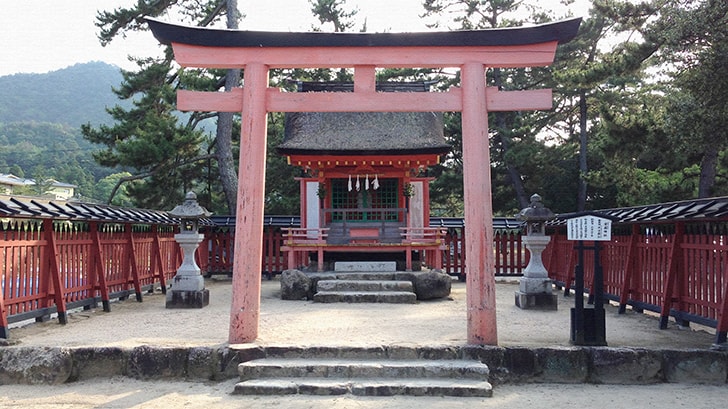Miyajima Island is located in Hiroshima Prefecture.
It is a popular tourist destination, with 14% of the island being a World Heritage Site.
There are many shrines and temples on Miyajima.
In this article, I will write about my visit to Daisho-in Temple, Kiyomori Shrine, and Toyokuni Shrine.
A tour of shrines and temples is recommended when sightseeing on Miyajima!
There are many shrines and temples on Miyajima.
So far, we have visited Mt. Yayama and Itsukushima Shrine and enjoyed their beauty.
Shrines and temples were closely connected until the first year of Meiji (1868), when the Shinto and Buddhist Separation Order was enacted, and it seems that shrines and temples have built up their own culture on Miyajima.

When visiting shrines and temples, you can take a pleasant stroll along the alleyways, where the rows of houses also have a pleasant atmosphere.
We recommend that you take your time and enjoy the atmosphere of the town as you make your way around the shrines and temples.
Daishyoin Temple
The first stop is Daishoin Temple.
It is located a little further away from Itsukushima Shrine.

It is located at the foot of a mountain, so the greenery becomes thicker as you approach Daishoin.
The trees are alive and vibrant, and the atmosphere is full of life.

This is the main gate of Daisho-in Temple.
The architecture of the gate is also very atmospheric. It is a beautiful structure with a sense of history.
Daisho-in Temple is the oldest temple on Miyajima.
It is the head temple of the Omuro school of the Shingon sect of Buddhism, located at the foot of Mt.
It is said that if you make a single wish at Daisho-in Temple, it will come true. My wife made a wish when she visited four years ago, and her wish was granted.
Since I was planning to pay a visit to the temple to express my gratitude, I went to the main hall with great enthusiasm.

We climbed the long flight of stairs to the main hall.
But at this point, a person from the Daisho-in Temple came down from above and told us that it was time to leave.
We couldn’t make it to the top and had to turn around, but we were able to join hands with the Daisho-in staff from the bottom.
The Daisho-in Temple is open from 8:00 to 17:00.
Please be careful of the time when visiting the temple!
Kiyomori Shrine

Next stop is Kiyomori Shrine.
It is visible from the Otorii gate of Itsukushima Shrine and is located on the opposite shore from the ferry entrance.
As the name suggests, Kiyomori Shrine is dedicated to the god Taira no Kiyomori.
When the tide is low, visitors can walk to the shrine from the shore on the ferry landing side, next to the Otorii.

Taira no Kiyomori built the shrine pavilions of Itsukushima Shrine and built it to its present scale.
We were grateful for the wonderful experience and joined hands with him.
Toyokuni Shrine, commonly known as Senjokaku 《Important Cultural Property》
Our last stop was Toyokuni Shrine.

Toyokuni Shrine is located up the stairs across from Itsukushima Shrine.
It is located on a fairly high hill, so the view is good, but the climb up the stairs may be a bit difficult.

The shrine also closes around 17:00.
However, the Daikyodo Hall, which is said to have been built by Hideyoshi Toyotomi, is not yet completed and is in a stairwell.
Since construction was halted after Hideyoshi’s sudden death and there are no board walls, you can view the interior from outside even after hours.

It is the largest building on the island, and is also called Senjo-kaku, or “Thousand-mat Pavilion,” because it is the size of 857 tatami mats.
In the Edo period (1603-1867), it was a popular place for people to socialize and enjoy the cool of the summer. On a large pillar are inscribed the names of a group of Kabuki actors of the time and willow trees.
Goju-no-to (five-story pagoda) 《Important Cultural Property》

Next to Toyokuni Shrine is a five-story pagoda.
Many visitors probably come here because it can be seen from the ferry.
This five-story pagoda is an architectural style that skillfully blends Japanese and Chinese styles.
The tower is 27.6 meters high, and the contrast between the cypress bark roof and vermilion-lacquered pillars and rafters is beautiful.
Conclusion
There are many shrines and temples on Miyajima Island, and I felt my power grow as I visited each one.
It is a power spot, isn’t it?
By touching the historic architecture and walking around the powerful places, I had many experiences that I would not normally have.
While being impressed by the shrines and temples, Miyajima is a place where you can enjoy every part of the island, such as seeing a large ladle (shakoji) as you walk through the shopping street.

Walking around the island, you will find many interesting discoveries.







コメント